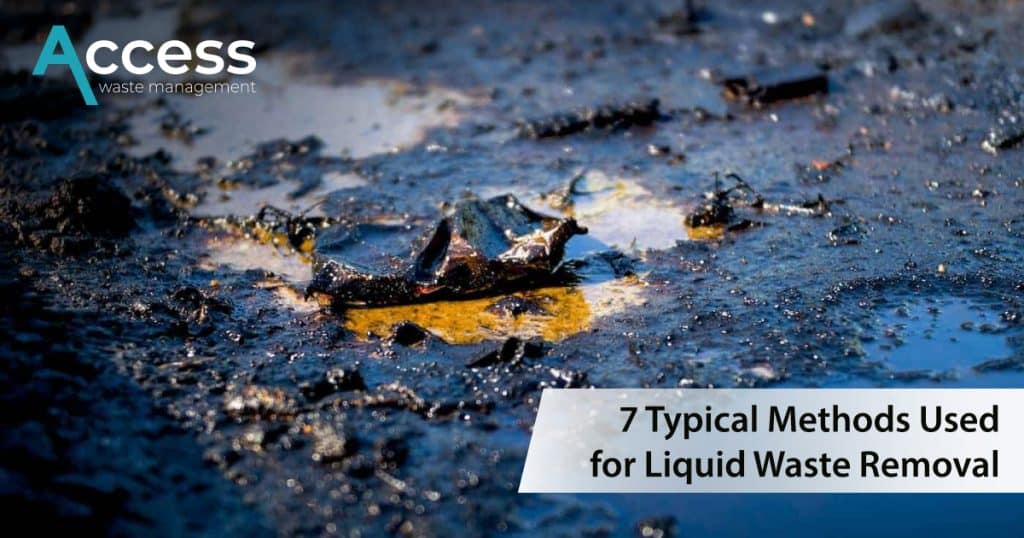
The following are seven of the most common liquid waste removal methods:
- Sedimentation
In that it separates water from solid waste, sedimentation is similar to dewatering. It separates the two states of matter using gravity rather than centrifugal force. A facility deposits its liquid waste removal in a sedimentation basin during sedimentation.
Because the velocity of liquid waste removal is often sufficient to keep solid particles suspended as long as it flows quickly, the design of a sedimentation basin reduces that velocity. Solid suspended particles settle to the bottom of the basin as the wastewater slowly flows through it. The solids can then be removed from the facility, leaving the solid sediment waste behind.
- Incineration
In some cases, hazardous waste is incinerated by facilities. Acids, chemicals, oils, rock tailings, slag, and other waste matter can be removed by the heat from specialised furnaces, leaving only water behind. This technique employs two types of furnaces:- Furnace with Fluidized Beds
A fluidized-bed furnace is an industrial furnace that uses pressure to transform a bed of solid particulate matter or solid-fluid mixtures into a fluid. These incinerators have a heated, bubbling bed of sand, ash, or limestone that is pumped with oxygen to facilitate heat combustion. Because of their large size, they can burn completely and efficiently. - Furnace with Multiple Hearths
A multiple-hearth furnace incinerates large volumes of waste at different stages at steady, consistent rates using many stacked chambers. The chambers are compact and easy to fit into small spaces because they are stacked, and they are also relatively inexpensive to build and instal.
- Furnace with Fluidized Beds
- Solidification
Adding binding agents to wastewater causes the waste to solidify into a compact, rigid, easily disposable solid. Many solidification processes add bulk and rigidity to liquid waste by using lime ash, sawdust, cement kiln dust, lime kiln dust, gypsum, phosphate, or flying dust, or they may use asphalt or cement for added reinforcement. Companies can ship solid waste blocks to approved landfills for disposal or waste-to-energy facilities for incineration and energy generation after solidification.
Solidification is frequently combined with another process known as stabilisation. Solidification changes the physical properties of waste, making it harder, stronger, or less permeable, as well as enclosing any hazardous contents. Stabilization reduces the likelihood of hazardous components leaking into the environment, for example, by making them less mobile, soluble, or toxic.
- Dewatering
Dewatering is an effective method for compacting nonhazardous waste and making it more suitable for disposal. Typically, the facility pumps the liquid waste into a strong bag and removes the water, leaving only solid waste. A landfill typically does not accept free liquid, but solid, nonhazardous waste can be disposed of there.
Filtration and treatment of the water are performed as needed. Centrifugal dewatering and thickening are common options for liquid waste dewatering, particularly for sludge. This method employs a cylindrical vessel to generate centrifugal force, which flings solids from liquids and causes them to solidify into a soft substance known as cake.
- Composting
Alternatively, facilities can compost their non-hazardous liquid waste. The facility first separates the water from the waste, leaving behind organic matter containing nutrients such as nitrogen, potassium, and sodium. The facility can then turn the material into organic fertiliser, which will also contain these beneficial nutrients to help crops and other plants grow, by using naturally occurring microorganisms.
Composting is relatively inexpensive in comparison to many other methods of liquid waste disposal. It is also extremely gentle on the environment, and even beneficial to soil and plant growth.
- Root-Zone Treatment
Root-zone treatment is most effective for relatively clean domestic wastewater such as kitchen water, bathroom shower and sink water, and laundry water. This treatment is a complicated process that involves passing liquid waste through a sedimentation tank and then through various additional filtration processes, including, eventually, the roots of growing plants. As a result, the water meets the requirements for release into the environment.
A series of filtration processes, such as these, may be used in root-zone treatment:- Pretreatment Sedimentation
The water is first placed in a sedimentation basin, where some of its solid particles can precipitate out and be easily removed.
- Reactor Anaerobic
The liquid waste may then pass through an anaerobic reactor in the following step. The reactor is usually baffled, which creates many internal compartments for the water to flow through. The microorganisms gathered on the compartment surfaces digest more of the suspended solids as the water passes through.
- Filter, Anaerobic
Microorganisms can form colonies in an anaerobic filter’s filter medium. These microorganisms digest more of the suspended particles, resulting in cleaner liquid waste.
- Gravel Filter with Plants
Following the initial treatment, the water flows through a gravel bed with live plant roots. The plants are frequently strong reeds that provide resistance to the flow of water. As the plants respire, they add oxygen to the effluent and aid in the removal of any remaining contaminants.
- Pretreatment Sedimentation
- Disposal
The only other option is to dispose of the liquid waste as is, often with the help of a professional waste management company. Their facility collects its liquid waste in the appropriate drums in this case.
Their company then collects, transports, and disposes of them by state and federal regulations. This option is especially appealing for businesses that want to remain compliant with regulations without investing significant time and energy in doing so.
Protect your business and the environment today – Schedule a professional hazardous waste removal with Access Waste! Call us now to request a quote and ensure safe, compliant disposal of your hazardous waste.

